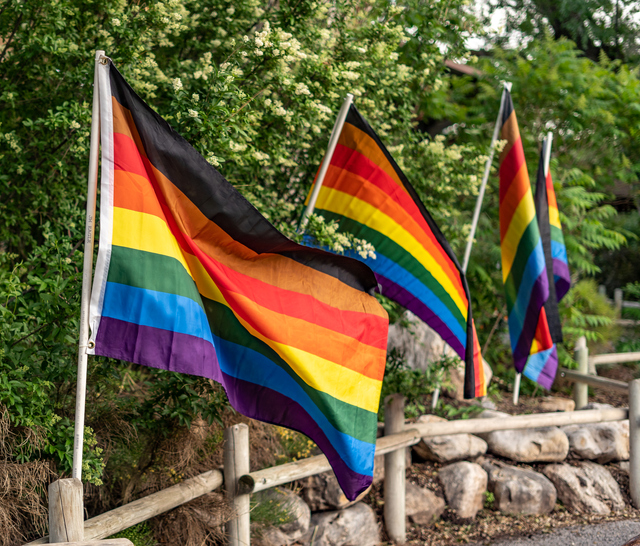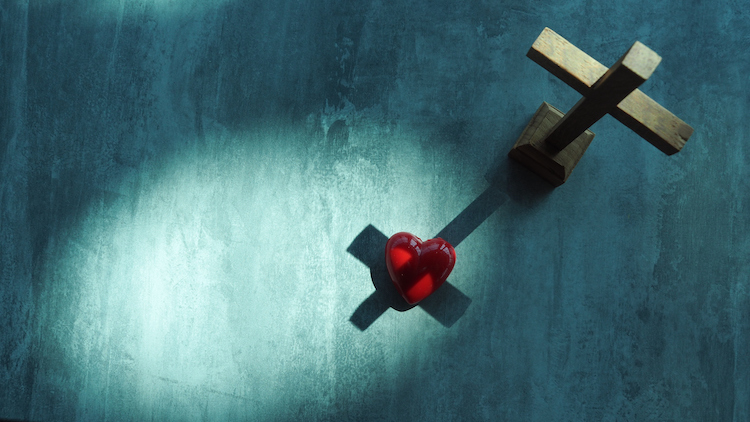The tyranny of the gay-stream
The privileging of white, atheistic queer identity in Australia
Featured in

‘WOULD YOU LIKE to help advocate for oppressed Arab queer youth in homophobic and conservative communities like your own?’ a white woman asked me earlier this year, her voice flustered and breathless through the phone.
She was co-ordinating community roundtable discussions with a civic action group. She was ill-equipped for the task, being a complete outsider to Arab ethnic and ethno-religious identity. This was a classic case of a white person keen to ‘speak out’ for other people’s communities, a situation that often has damaging consequences. Unfortunately, it’s a phenomenon I’m seeing more and more of – particularly when it comes to the complicated relationship between faith and sexuality.
ON THE PROJECT earlier this year, Reuben Kaye – a comedian, cabaret star and drag artist known for his boundary-pushing style – quipped, ‘I love Jesus. I love any man who can get nailed for three days straight and come back for more.’ These words caused a furore on social media.
Kaye defended his statement on an episode of Q+A: ‘If we are not visibly queer then the most vulnerable in society never become visible. They disappear. And we lose – you all lose – too many of your children.’
Though I didn’t enjoy his joke, my contention is not that Kaye was morally wrong or even offensive in his comments – religion is fraught and humour is subjective. Rather, it’s his call to ‘speak out’ for young queer people – and the implication that his joke and his brash brand of flamboyant performance does this – that rings false to me.
Gay identity is not a single, fixed thing. But the flamboyant brand of this identity, which is on display at Pride or Mardi Gras, seems to have become the most important and recognisable version of queerness in the public imagination. When we focus on this entitled, Western version of gay identity, entire communities get overlooked.
Arab Christians, the community of which I’m a member, are Copts, Maronites, Jacobites (Syrian Orthodox), Chaldeans and Nestorians. Australia also has a substantial proportion of Indian Christians, who in the Catholic Church identify as Syro-Malabar. My own ancestral group of Egyptian Christians, who are mainly Coptic Orthodox, number around 20,000 in the state of New South Wales alone, according to the 2021 census.
Many gay people I know – certainly the queer Arab Muslims and Christians who form my friendship group – navigate faith and family in subtle ways, belonging to both factions and reconciling them deftly. Many of them do this without public declarations of their identity, gay, straight or otherwise.
The truth is, ‘coming out’ can be life-threatening for many queer people of faith. At a Muslim community event for queer people, I was told by one of the organisers that Afghan community mullahs right here in Sydney threaten the lives of their young queer people. Unfortunately, this behaviour occurs in other faith communities of colour, too. Ethnic Christian communities were most likely to vote no in the 2017 same-sex marriage plebiscite. At the time, I heard parish priests make comments such as ‘In this country, there is no fear of God. A man can do whatever he wants, even marry his own brother.’
Research that came out post-plebiscite showed a significant lack of advocacy by Equality Australia, one of the organisations that led the Yes campaign, in spaces where these communities live. Queer people of colour and faith were basically placed in a ‘too hard’ box, furthering the white queer advocacy that claims to speak for us all.
For the Catholic community, in particular, Kaye’s comments were like kindling to a homophobic fire. Days after that episode of The Project aired, One Nation NSW leader at the time, Mark Latham, addressed a church-organised meeting at St Michael’s Belfield about his concerns that the ‘trans agenda’ was eroding parental rights. LGBTQ group Community Action for Rainbow Rights (CARR) invited its members to protest outside; the activists were pelted with stones and glass by an angry mob on the church steps.
DESPITE THESE DISPLAYS, Australian society and the white gay community still value a public, performative, Mardi Gras-friendly take on queerness above all others – a fundamentally racist position that parallels white Australian attitudes towards cultural diversity. As anthropologist Ghassan Hage argues in White Nation: Fantasies of White Supremacy in a Multicultural Society, Australian versions of multiculturalism are performative: tolerance is the nearest thing to actual acceptance that can be offered in a predominantly white society. It’s a mindset through which the white-majority Australian nation has separated itself from the atrocities committed during British colonisation – especially towards Aboriginal people – and the racist policies that limited migrant intake to Anglos, Celtics and Western Europeans until the mid 1950s.
These colonial-era racial structures are prevalent in gay culture, too, where gay saunas cater to specific ethnic clientele depending on their location. In his study of racism in Western Sydney’s gay sauna scene, academic Rodrigo Perez Toledo explains that the racial lines along which these saunas are divided (for example, ‘Asian only’ saunas in the western suburbs) reflect the fundamental racism inherent in Australian multiculturalism. I’ve seen this hierarchy of race play out firsthand on apps like Grindr and in bars and clubs. A friend summarised it aptly, ‘Hook-ups take a certain order: white Potts Point gays get picked up first, then Arabs, then Asians.’
This white version of queerness, which is often atheistic, creates a false dichotomy between theism and homosexuality, a view held by many white progressives – including Reuben Kaye. And Kaye’s claims to advocate for marginalised (read: non-white) gays who cannot speak for themselves only reinforces that racial hierarchy.
YET THERE’S PLENTY of evidence that gay identity and cultural heritage can comfortably coexist for queer people of colour. Budi Sudarto is a queer researcher of Indonesian-Muslim descent at Monash University and the founder of a cross-cultural consultancy group. They are a co-author of ‘“You Can’t Be Gay and Do Religion”: Understanding Muslim LGBTIQ+ Experiences of Accessing Support Services’, published last year in the Journal of Intercultural Studies.
‘We just don’t talk about sexuality in the same way that Anglo-Australians do,’ Budi says.
‘If I had “come out” and said this is how I am and you have to accept me, there is a huge possibility that my family would say “no” and “This isn’t how we raised you.”… It’s not a question of conservatism, it’s more about how we frame sexuality in our culture.’
Budi explains how dangerous such binary notions of identity can be for queer people of colour. ‘This concept that we have to come out and force people to accept us just doesn’t work for us… If we can find a place to exist and to navigate according to cultural and religious settings, for me as a queer Muslim that works better than having to constantly feel the need to come out and assert yourself. There are many ways to assert yourself without the need to come out.’
To elevate voices that represent the lived experience of our own communities, we need genuine consultation with those communities and a willingness to speak to organisations working within them. In the aftermath of this year’s Mardi Gras, which was criticised for prohibitive pricing and capitalist elitism, this is the kind of true inclusion our multi-ethnic and multi-faith queer community deserves.
If white activists want to be true allies to queer people of colour, it’s time for them to let us speak for ourselves. We don’t just want to be protected; we want to be recognised as a distinct and valid part of the queer community whose experiences are substantially different to the white mainstream. This is the kind of real inclusion we can all agree on.
Share article
More from author

See through a glass darkly
Non-fictionOn the way home that night we pass Oxford Street. It’s lit up and people are dancing in the windows of the clubs. There’s a rainbow flag on one of the buildings. Dad turns to look at this with a grimace: he shakes his head and sucks his teeth. He turns the volume up on the CD player and focuses on the road ahead.